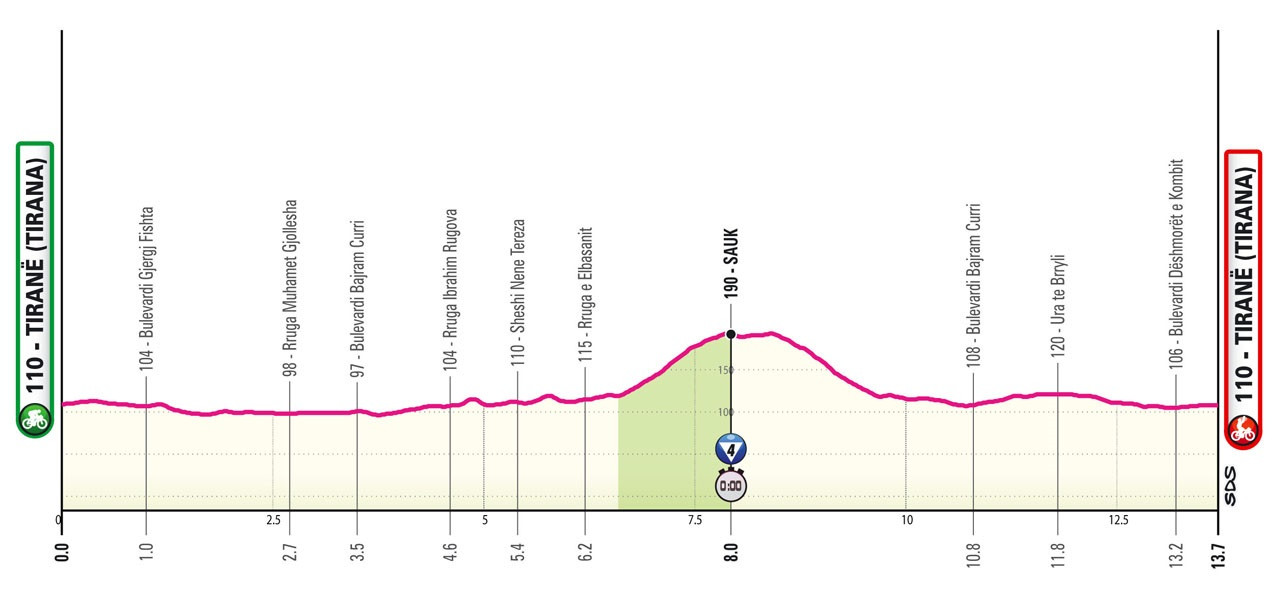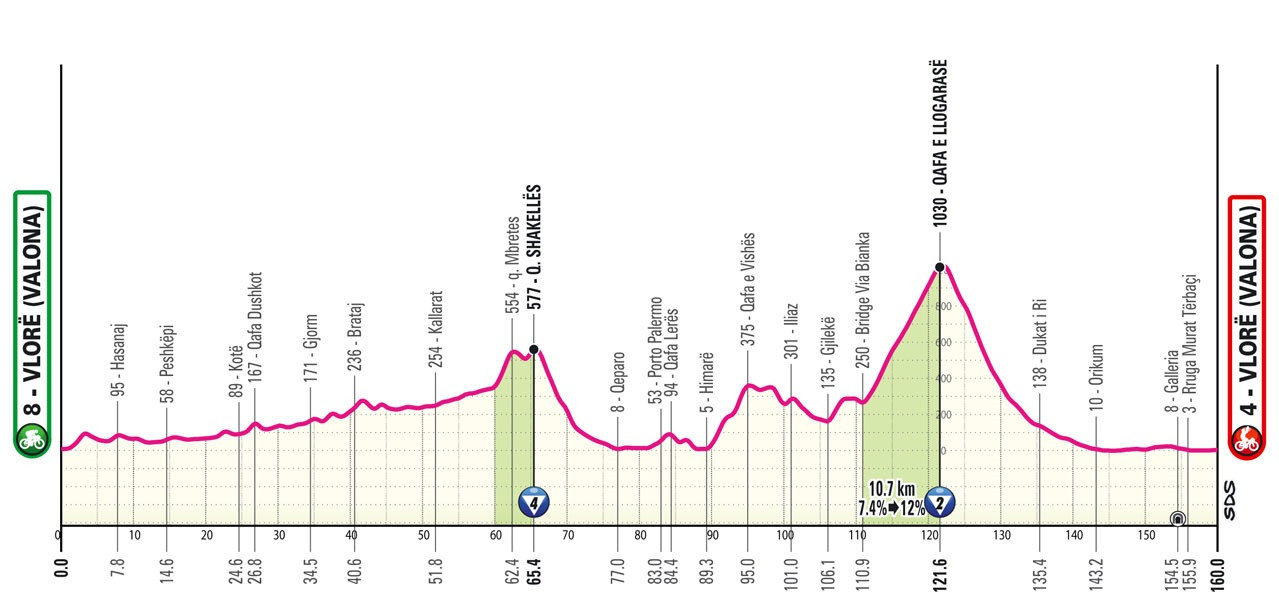Kick-off in Albania, scenic white roads, and an exhilarating third week. What can we expect from the Giro d'Italia 2025 route?
At one point, the agreement with the Balkan country was on the verge of collapse for two reasons: deteriorating relations between Italy and Albania at the state level, and the Albanian side's last-minute desire to renegotiate the terms of the agreement, seeking to reduce the amount they would pay to the organizers of the Giro, the company RCS Sport. The latter had already begun to explore an alternative option for the Grande Partenza in Sicily, but ultimately a compromise with the Albanian side was reached.
The delay in presenting the Giro route created planning issues for teams as they prepared for the new season, leading to rumors that they received a draft of the "Corsa Rosa" route, closely resembling the final version, as early as late November.
 5
5Thus, Giro-2025 will take place from May 9 to June 1, marking the race's first visit to Albania in its history. During this period, there will be a total of 21 stages covering a distance of 3413 km, with three rest days instead of the usual two. This format has been used in the Giro multiple times when the race started outside of Italy. Riders are given an extra rest day to calmly transfer to the Apennine Peninsula after three initial stages in Albania. The total elevation gain over the three weeks will be 52,500 meters.
Out of the 21 stages, 2 will be individual time trials with separate starts – 13.7 km on the second stage in Tirana and 28.6 km on the tenth stage between Pisa and Lucca. The average distance of the 19 group stages will be 177.5 km – 5 km more than at the Tour de France-2025. Among the 19 group stages, 7 will be flat and hilly, while 5 will be high mountain stages. In addition to the start in Albania, the Giro will leave Italian territory once more: at the end of the second week, the race will visit Slovenia, finishing in Nova Gorica. The race will conclude for the third consecutive time with a sprint stage to Rome.
The First Week: Albania and White Roads
The first three stages in Albania will be quite challenging, providing no opportunities for pure sprinters. The race will kick off with a 164-kilometer segment from Durres to Tirana. Midway through the distance, riders will face a Category 2 climb at Gracien: 13.5 km with an average gradient of 5.2%. 45 km from the finish, the riders will enter Tirana, where they will tackle two laps featuring a climb of Category 3 at Surrel, the last of which occurs 11.3 km before the finish. Pure sprinters will likely struggle here, and if desired, the first stage could even serve as a preliminary test of strength for the general classification contenders.
 6
6Following this, riders will remain in the capital of Albania, where, as mentioned earlier, they will face the first time trial. This will not be a flat course either: in the middle of the nearly 14-kilometer distance, they will encounter the Sauk hill: 1.8 km with an average slope of nearly 4%. However, the main challenge may not be the terrain but the technical aspects: the numerous sharp turns are a typical feature of time trials that take place within a city. If it rains in Tirana, it could become quite dangerous.
 7
7The toughest climb of the Albanian portion of the Giro awaits the riders on the third stage, starting and finishing in Vlora. 50 km from the finish, the assault on the Kafa e Llogarasë pass will begin: 10.7 km with an average gradient of 7.4%. This climb has been rated as a Category 2, even though it could easily qualify as a Category 1 due to its difficulty. However, the fact that its summit is located 38.4 km from the finish significantly reduces the chances of seeing a head-to-head battle among the top general classification contenders here.
 8
8After three stages in Albania, the riders will enjoy their first rest day, after which the race will move to the southern part of the Apennine Peninsula. Only upon returning to Italy will the sprinters have their first opportunities to shine. There may even be three chances in a row. The fourth stage from Alberobello to Lecce will be flat, while the finale of the fifth stage to Matera will not be entirely flat. Nevertheless, the pre-finish hills are not too severe, so if they do disrupt anyone's chances for victory, it will likely only be pure sprinters like Fabio Jakobsen.
 9
9The sixth stage to Naples will also start with hills, but the finale will be completely flat. Hence, it is likely another opportunity for sprinters, while the terrain's challenges at the beginning will only impact the formation and composition of the day's breakaway.
After three sprint days in southern Italy, the riders will begin heading north, and on the seventh stage, they will enter the Apennine mountains, where they will face the first mountain stage and the first mountain finish of Giro-2025. The 168-kilometer distance from Castel di Sangro to Tagliacozzo will begin with an assault on the Roccarazo climb, which has previously served as a finish for both the Giro and Tirreno-Adriatico. In the middle of the stage, there will be two Category 2 passes: Monte Urano (4.5 km, 9.4%) and Vado della Forcella (21.6 km, 3.6%). The first mountain finish in Tagliacozzo will not be too difficult: 12.6 km with an average gradient of 5.4%. The climb is relatively easy, with the steepness exceeding 7% only in the last 3 km. One can only reiterate the well-worn phrase: "on such a stage of the Giro, you can lose, but not win."
 0
0The following day will feature another stage with Apennine hills, but with a rather simple finish in Castelraimondo. Such a route is perfect for a successful breakaway.
 1
1The first week of the Giro will conclude with one of the main highlights and gems of this edition of the "Corsa Rosa" – a stage through the white roads of Tuscany, winding through vineyards. The first half of the 181-kilometer distance from Gubbio to Siena will be straightforward, but the excitement will begin 70 km before the finish. Three consecutive long and predominantly flat sections of the famous white gravel roads of Tuscany, known as "sterrato," host the renowned one-day race Strade Bianche each year – a very challenging trial.
 2
2In the final 35 km, riders will encounter two more short sections of white roads (the total distance of sterrato is 29.5 km) and the traditional steep finish climbing to Piazza del Campo in the ancient and picturesque center of Siena. This stage will surely provide aesthetic enjoyment and, likely, will be significant in terms of the overall classification, especially if it rains in Tuscany that day.
Second Week: Time Trial, Mountains, and a Visit to Slovenia
Next comes the second rest day, after which the race will resume with another crucial stage for the overall classification: the second time trial. Unlike the first individual time trial in Tirana, this one will feature a practically flat terrain. The main challenge of this time trial lies in the fact that it will occur right after a rest day: this always poses the risk that some of the top general classification contenders may struggle to find their racing rhythm after the break.
 3
3Following the time trial, the 11th stage will not be easy either. The peloton will head north